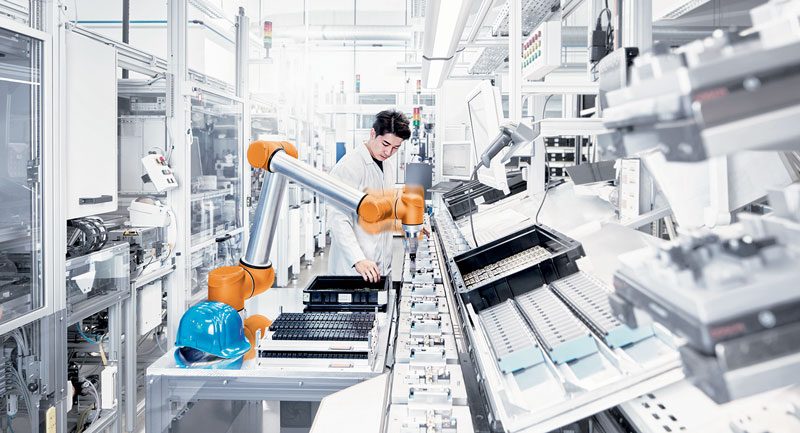How to Automate Processes, in Full Safety
The concepts of safety and automation can hardly be separated in the current production scenario, and the assembly field is no exception. With the support of SICK’s experts, we could explore the product portfolio of the German company, looking for the most innovative solutions for safety management in robotic work cells as well as the state-of-the-art systems for quality control and process traceability.
by Fabrizio Dalle Nogare
The optimal and safe management of a work space shared between machines, robots and operators is a key issue of an advanced production system. In order to balance efficiency and operator safety, therefore, devices are needed in order to monitor the access of operators to the work area and ensure that the machines slow down or even stop if there is a risk of contact with the operator himself.
Devices such as laser scanners can be used for this purpose. One example is the shared work areas between operators and collaborative robots. “Compared to the traditional ones, the cobots – explains Marco Sordelli, National Application Engineer Industrial Safety at SICK – are equipped with native safety functions, which can be integrated with SICK safety devices, such as laser scanners. These can handle several pre-set work areas, allowing a robot, for example, to work at full speed when the operator is away and at reduced speed when the operator approaches”.
In particular, SICK’s new safety laser scanners, microScan3 Series, relying on SICK’s innovative safeHDDM™ proprietary scan technology, ensures that areas, access and danger points are protected even in harsh environmental conditions. “Compared to the previous generation – adds Eng. Sordelli – the microScan3 scanners, available in stand-alone version or directly integrated into the customer’s safety PLC, are able to better filter out environmental interferences, such as lighting, reflections, optical or physical interferences such as dust, chips or scraps”.
The safety barriers are easy to integrate
Other quite popular devices when it comes to machine safety are the barriers. SICK’s deTec4 Series barriers are featured by high integration and simplified installation, as well as a protective field height ranging between 300 and 2100 mm.
A green/red LED allows users to monitor the operational status of the safety barrier at any time, while the operation and alignment indicators show fault codes, thus simplifying diagnosis in case of a breakdown.
“The 14 mm resolution means that the deTec4 Core barriers can be installed close to the danger area”, says Marco Sordelli. “In addition, the IP65 and IP67 protection standards, combined with the operating temperature ranging from -30°C to +55°C, make the barrier extremely reliable even in harsh environments. If we want to say something more on barriers, customers have indeed increasingly strict requirements in terms of space. For this reason, SICK has in its portfolio several solutions with reduced size”.
The potential of 3D vision systems
Moving from safety to process automation, we asked Eng. Marco Catizone, Head of Industrial Integration Space at SICK, what are the current needs of manufacturers of automatic and semi-automatic assembly and testing machines.
“Quality control and product traceability along the whole production chain are primary requirements, to be sought through reliable and flexible tools able to adapt to the most diverse situations as well as work environments. The range of solutions we provide is intended for both traditional assembly machines and robotic systems and includes, for example, smart sensors, i.e. sensors with advanced functions, such as counting or timing, which add intelligence while at the same time relieving the PLC of tasks that in theory should be due to it”.
In terms of quality control, however, there is great potential for vision systems, both 2D and 3D: these systems are increasingly integrated and easy to use and program. SICK’s Ranger3 camera, in particular, has a resolution of 2560 x 832 pixels and, thanks to ROCC (Rapid on Chip Calculation) technology, can acquire up to 7,000 profiles per second on the entire sensor and up to 46,000 profiles/s if only a part of the sensor is used. This happens, for example, when wide fields are framed in which, however, objects of limited height pass through.
The TriSpectorP1000 is a programmable stand-alone 3D camera that captures 3D images of moving objects on the production line using the principle of laser triangulation: the object height is detected regardless of contrast and colour, for extremely accurate results even at high speeds.
“The possibility of getting acquisitions of parts even in 3D makes it possible to evaluate also their morphological properties, therefore making it possible to check some key assembly operations, such as screwing or tightening, for example. Ease of control and increased security are certainly among the advantages of 3D cameras”, explains Mr Catizone.
Tracing the piece history back
Talking about the current needs in the assembly field, how not to mention the unique identification of parts in order to achieve complete traceability of the production process.
“Today, manufacturers are asking to be able to identify each single item along the chain”, confirms Marco Catizone. “In short, we are moving from the tag with RFID identifier on the workpiece holder pallet to the tag put on the piece itself so that it can also be identified at the end of the assembly process and its full history can be traced through the RFID system”.
To this end, SICK has included in its catalogue the RFU65x RFID read/write device, capable of detecting long-range transponders and simultaneously recording the position and direction in which objects move. The collected data can be sent directly to an ERP or MES system, thus reducing processing time.

